© Drums for Schools Ltd Teaching support and resources available from www drumsforschools com
A

© Drums for Schools Ltd Teaching support and resources available from www drumsforschools com
A
guide to the music of West Africa and how to explore it with your students
Compiled by Richard McKerron and Dr Elizabeth Stafford with core content from Andy Gleadhill

This teacher guide is designed to be used in conjunction with the West African Djembe Drumming Scheme of Work. It will introduce you to the wider historical and cultural context of the music of West Africa, and help you to develop your technical knowledge of how to play and teach djembe drums.
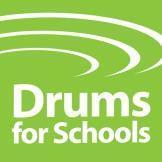
A. Music of West Africa
1. Historical and Cultural Background
2. Context and Delivery
3. Tribal Influences
4. Influences on Other Cultures
5. West African Music Today
B. The West African Djembe Drum
1. Classifications and Descriptions
2. How Djembes are Made
3. How to Play the Djembe
C. Introducing West African Drumming into your School or Setting
1. Different Ways of Introducing Djembe Drumming
2. Teaching Approach
3. Useful Hints and Techniques
4. Available Teaching Resources

There is a wonderful origin myth that tells us of a chimpanzee who originally had the first drum, and of a hunter who trapped the chimpanzee drummer. From that day on chimpanzees would beat their chests instead of the drum in anger of the theft.
Association of the Djembe is originally with the Numu, the blacksmiths, within the Mandinka tribe of West Africa and the general initial spread of the instrument was in line with the Mali Empire. Somebody who plays a Djembe is called a Djembefola and there are no historical restrictions on who could learn to play the Djembe, unlike some other instruments that were sometimes reserved for the storyteller-historians known as Griot.
The Griot have an important role in communities as they are well versed in the histories, the songs and contemporary events. They often specialise in other instruments such as the Kora or the Balafon. Over the years it was a role that was taught specifically to individuals, often within a family, and they would usually marry with other Griots instead of outside of the acquired role. In more recent times, however, rules are relaxing and some characters like Youssou N’dour have distinct links back to a Griot approach. Internationalism has seen some griot move to other countries to spread the word and knowledge of Africa around the world, such as Papa Susso. Griot learning establishments have also appeared which allow non-Griot family individuals to become one, although many of these focus more upon musical skill than the oral histories.
Djembe music is ingrained into the daily life and culture of a traditional village in rural areas. Villages would drum to celebrate all sorts of things including dignitaries visiting, weddings, funerals, a successful hunt, a ritual fishing day and so forth. Everyone takes part in some respect and if you aren’t drumming or singing then it is likely that you are dancing.

Music is very important to West African villages. Every important event has designated rhythms that are to be performed. The entire village gets involved and it brings the community together. An excellent short documentary that is worth watching is called Foli; There is No Movement Without Rhythm which gives a wonderful snapshot into life in a Malinké village and how rhythm forms both the work and the play that the people engage in daily.

This sort of approach and performance in the villages is referred to as ‘Rural’ style as it is what they do in the more rural areas. Within the village they tend to form a big circle or square and perform within it.
As time moved on, travelling drumming troupes became an established concept and would perform for specific arranged audiences, often with a troupe of associated dancers. This is referred to as ‘Ballet’ style and is usually performed on a stage or at the end of a building or hall. Hotels and other establishments may also hire a troupe to entertain guests in tourist districts.
As a sweeping generalisation, each general tribal area will have developed its own take on performance and set rhythms according to their culture. With the spread of interest in the styles of music and freedom of travel it is likely that the lines between these will blur over time, but alongside more recent documentation of rhythms in writing and amateur video documentation it appears that different areas have some distinctions; some are more upbeat, some steady, some complex, some minimal.

It isn’t helpful to think of a tribal area as being in line with country borders, as over time people and groups and moved, spread out, blended and travelled and original tribal areas are not necessarily strictly in line with the modern borders that we see on maps today.
Different areas also favour certain drums or combinations of drums together. Other instruments such as the Balafon and Calabash may be incorporated.
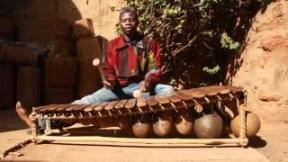

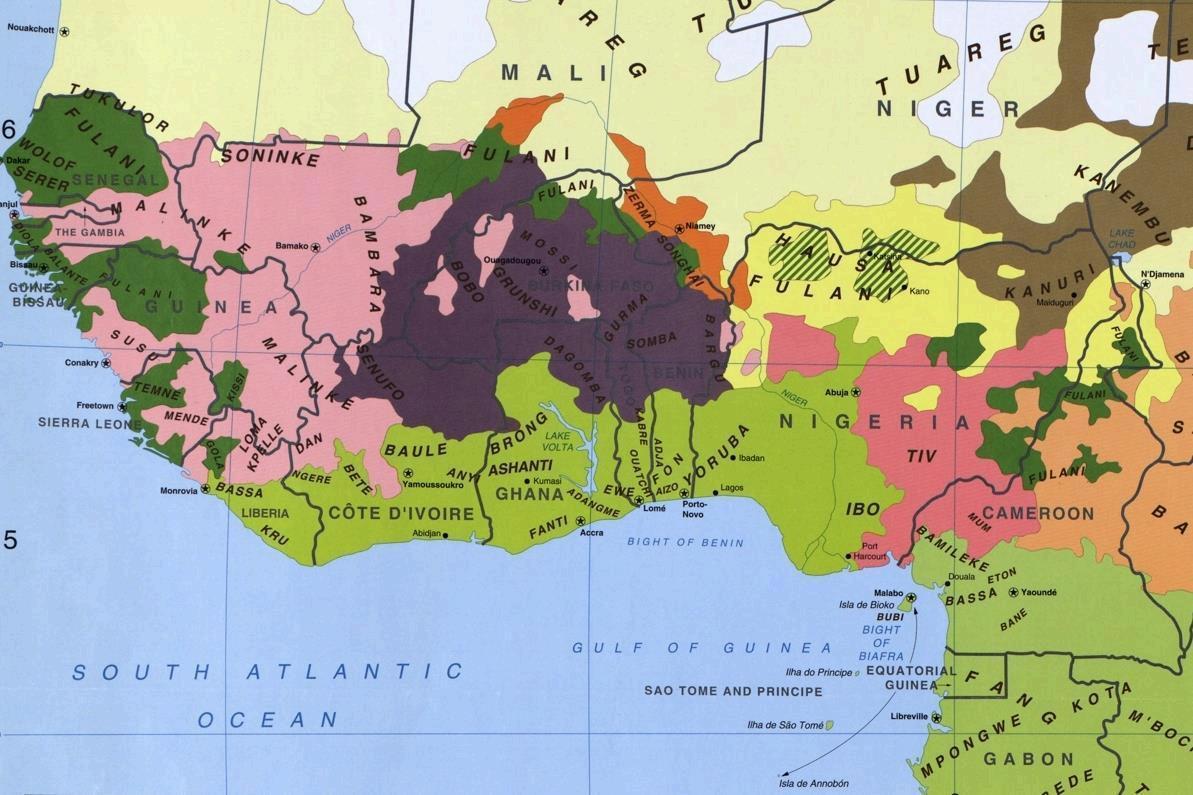
Source: Public Domain image from the Library of Congress here.

The rhythmic patterns and systems that underpin much of the traditional music produced across the continent of Africa has significantly influenced waves of music in North and South America (and consequently the rest of the world) in large part due to the trafficking of enslaved people. African people brought their rhythmic musical traditions to the new world, where these eventually combined with the melodic traditions of the European settlers to form new musical styles.
For example, many African people enslaved by Portugal ended up in Brazil, a significant amount into Rio de Janeiro. There is evidence of Candomblé being merged with Catholic Church celebrations to create carnival and other celebrations with heavy dance elements that in turn required strong 2/4 rhythms, which will have drawn influence from Western Africa again. Over time Samba and its variations were given form as we know it today.
Afro-Cuban music contains significant influence from West Africa too, especially in relation to polyrhythms, cross-rhythms and the concept of performance in a social environment. The rest of the Caribbean has also seen influence, especially in Jamaica where in particular Nyabinghi Djembe Drumming sees rhythms from West Africa used and adapted to support a more syncopated feel in conjunction with Reggae- style vocals. The music is much slower than West African Djembe performances in general, but allows for lots of space between beats to allow little improvisations and additions to be thrown in. The social performance element is also retained.
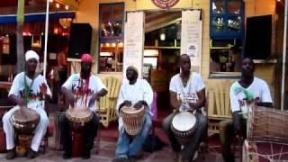
In North America the most well-known development is Blues. Vocally, many songs that accompany the drumming have lines repeated and some follow an AAB structure that we now find commonplace to the blues. The swing rhythm falls in line with some of the traditional 12/8 rhythms, but swung

rhythms had clearly been around in North America for years before this. Bending notes whilst singing may have also come from the African approach to singing these melodies.
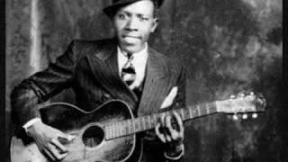
While there are still many proponents of traditional Djembe drumming living and performing in West Africa, it is also important to recognise that this is far from being the only style of music experienced in this region. Like any other part of the world in the 21st Century, people listen to and perform across a wide range of musical styles in West Africa, using many different instruments and technologies.
1. Classifications and Descriptions
The Djembe is an hourglass-shaped drum that originates from West Africa and has a drum head traditionally made from goat skin. The Djembe drum is simple to learn and yet it is a versatile instrument, capable of producing a wide range of sounds, and is reasonably priced and readily available.
The djembe is commonly classified as “struck percussion”, “hand percussion” or “African percussion”. Under the more formal Hornbostel–Sachs system, which is based on the way the sound is made, it’s classified as a “directly struck membranophone” because it’s the vibration of the drumskin when struck by the hands that produces the sound.


Djembe drums can be made in a number of ways, including moulded or formed fibreglass and other mass produced ways. Whilst not ‘authentic’ these drums can be lightweight and cheap, and they often have synthetic skins on them.
But traditionally a Djembe is made of wood, skin, rope and three metal rings.


A traditional drum will have started as a tree. It will have been cut down and allowed to dry out. The outer shape will be carved and trimmed down using a lathe and the inside of the drum will be hollowed out before the goat skin is put on. The skin will have also been cleaned, dried and treated.
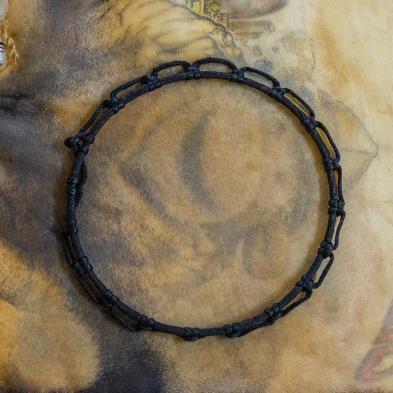

The three metal rings are harnessed to the drum to accommodate the vertical ropes and the skin is held in place by the top two of these rings at

the head of the shell. The goat skin tightens as the verticals are woven back and forth through the rope loops between the top metal ring and the bottom one. It is a slow process to increase tension over time so as not to stress the skin too much initially, but over a period of a few days the verticals are tightened and tightened.


It all seems quite straight forward mechanically, but the skill and quality of the build itself, ensuring that the head is perfectly round and even and having the strength, skill and tools to correctly add tension takes some training and practice.

The information in this section has been taken from Andy Gleadhill’s African Drumming Book 1
Position & Posture
To obtain the best tone and range of sounds from your drum it is essential that the Djembe is raised up from the ground and not played whilst it is standing on the floor. This is to allow the air and sound waves to escape from the bottom, open end of the drum. The method of sound production is easily demonstrated by holding your hand against the open end of the drum while another player strikes the drum - you can feel the escaping air. It can also be demonstrated by leaving the drum on the floor and playing a few beats and then doing the same with the drum off the ground and noting the improvement in the sound from the dead tone with the drum on the floor to the rich ringing tone of the raised drum.
When considering the best playing position to adopt you need to take account of the ages of the performers, the size of the instruments they are using, as well as the numbers in the ensemble. Generally speaking, a good playing position is to have the performers seated on the edge of a chair, to give more leg space for the drum, with backs straight and shoulders relaxed. The drum can then be placed between the thighs, just above the knee, and with the player’s feet crossed over on the floor around the drum. This will allow the player to have a firm grip on the drum and leave both hands free for playing.


The playing techniques of African drums vary enormously across the African continent with many different hand positions that not only change from country to country, but from village to village and each teacher will have a strongly held view as to how to play the drums ‘correctly’. Others believe that so long as a good sound is produced then technique is secondary.
It is important that the Djembe is played with hands and not drum sticks, as the goat skin is relatively thin compared to cow hide and it can cause stretches or splits which will damage the drum skin.
There are three main sounds that you can make with a Djembe: bass tone, open tone, and slap.
A good Bass note will produce a full and rounded deep tone. To produce a good Bass tone, the Djembe must be struck in the middle of the drumhead with the hand slightly cupped, palm down, with the hand returning quickly from the drum. You can use your whole arm and pretend that you are bouncing a basketball and this will result in the correct action for playing good Bass tones.
Click here to watch the accompanying video.
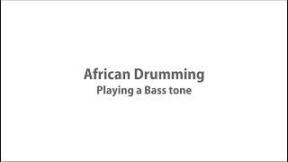

When playing the Open Tone the drum should be struck with the whole length of the fingers on the edge of the drum nearest to your body with your elbows slightly raised. If you imagine the drum head to be a clock face your right hand will be on the four and your left hand on the eight. Your hands must not remain in contact with the drum once you have played the beat but should return to your natural playing position just above the drum. A good way to achieve this technique is to imagine that the drum head is very hot, like a radiator, and so you do not want to leave tour hand on it any longer than necessary.
Click here to watch the accompanying video.
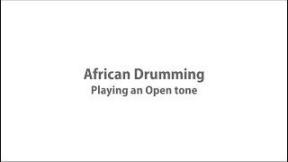
The Slap is a more advanced technique that can take quite a while to master. Moreover, whilst an adequate sound for a Bass Tone or Open Tone can be created with a loosely tuned drum, it is imperative that a Djembe is correctly tightened in order to get the most out of a Slap.
The type of sound that you are aiming for is a short bright crack. Some people mistake the Djembe’s natural harmonic ringing as the sound they are after, but it is more than this.
To play a slap you need to slap the pad of your palm (opposite side to the palm knuckles) down onto the edge of the Djembe where the skin is being pulled onto the wooden shell. Have your fingers relaxed and slightly apart and the hand angled slightly proud. If your fingers are relaxed enough then

they will follow through onto the skin and create the whip-crack sound of a Slap. The sound will not be muted as your pads will not be impacting on the resonant area of the skin.
Slaps are great to throw in place of Open Tones now and then to wake things up during a performance.
Click here to watch the accompanying video.

A West African Djembe Drumming Unit (perhaps based on the Drums for Schools Scheme of Work - see below) could be added to your existing curriculum to promote cultural diversity and decolonisation of the music curriculum.
A co-curricular Djembe club could be established for pupils to explore this music and develop their skills before school, during lunchtime, or as an after school activity. This could either be established as a purely musical activity, or as a wellbeing group; drum circle performances are an example of a ‘flow activity’ which is good for mental health and wellbeing.
Due to the accessible nature of these instruments, they are brilliant for transition projects, allowing you to carry out practical activities with prospective Year 7 pupils during transition days or projects.

For the same reason they will also work well for community or parent workshops as part of your school’s outreach programme.
No doubt as the teacher or group leader in other avenues you are used to being at the front of others leading a session. In Djembe performances a Master Drummer is essential to keep things running smoothly. They are the ones making the Calls to tell the others when and what to perform, as well as ensuring that everyone else is on track and playing the solos over the top of the set rhythms.
However, in a class setting it’s possible and even desirable to handle things differently. Group drumming lends itself particularly well to a collaborative approach, where everyone (teacher included) is learning together. The teacher will of course still need to manage the class, but do try delegating lots of the initiative, for example for making the calls in call and response, for setting the pulse, soloing etc. And don’t be embarrassed to check with your pupils - this is one class where you can enjoy being part of the group and where you don’t have to worry so much about being the expert.
1.
West African Drumming is traditionally learnt with an aural approach. This is much the best way to approach your teaching and it’s well worth spending time to listen to the pieces over and over again until they’re second nature. However, for those trained in a more notation-based tradition, it may be difficult to pick up and remember music by ear, and in this case grid notation is a very efficient way of documenting drumming rhythms and patterns. Most rhythms are in 4/4 meaning they can be subdivided into a grid of sixteen beats.

Some rhythms are based around a swung rhythm or triplets and in these instances a grid of 12 or 24 can be constructed and sub-divided into threes instead of fours.

The blank section underneath the numbers can be used to indicate which type of note is to be played (Bass, Tone, Slap, Low Tone, Open Tone, etc.)
They can also show which hand you should use in the rhythm, ‘R’ for right, ‘L’ for left and ‘F’ for Flam. Other two-handed combinations are possible for more advanced performance techniques.


One of the main basics of Djembe Drumming is to maintain a consistent ‘right, left, right, left’ pattern as this will give the performer an ample amount of fluency. If the performer is left-handed and would prefer to lead with the left, then reverse all of these instructions for them. The important aspect is their timing and their consistency of tone which can be created either way around, so long as they stick with the leading hand that they choose in the first instance.
Maintaining an even basic flow is a good starting point for all performers and will encourage an understanding of tempo and performing as a unit.
Click here to watch the accompanying video.
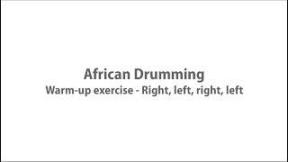
Moving from a ‘right, left, right, left’ pattern to a similar pattern with longer gaps inserted will show the underlying pulse and tempo of a piece of music as well as develop the skill of altering to a different pattern efficiently with no errors.

Click here to watch the accompanying video.

Double speed is another aspect of tempo altering and on the first few occasions that this descends into racket can provide an excellent discussion point on where things went wrong and what performers can do to avoid this.
Click here to watch the accompanying video.
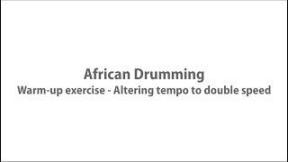
Click here to watch the accompanying video which shows how both of these tempo alterations can be put together as an additional exercise.
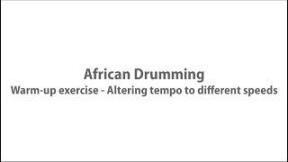

On rare occasions it is more efficient to use the same hand twice in a row and this warm-up does just this. It is not common practise to do this whilst Djembe Drumming but is a valid warm-up exercise.
Click here to watch the accompanying video.
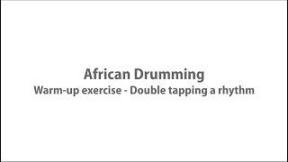
A Paradiddle is a constantly altering focus of left and right. There are many variations of a Paradiddle and with a little research you will see just how complex they can become. For now, though, this particular rudiment can be a great warm up for all, especially those unfamiliar with the concept as it gets their brains working.

Click here to watch the accompanying video.
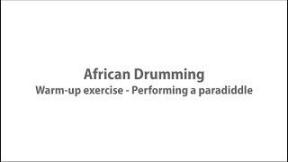
This warm-up exercise begins to explore the Djembe further and has performers playing Low sounds (Bass, ‘L’) and High sounds (Tone, ‘H’). The ‘right, left’ technique should be retained and is scored here below the tonal information.

Click here to watch the accompanying video.

We can further speed up the rhythm without altering the pulse by playing two Highs and two Lows instead of four.


Click here to watch the accompanying video.

We can also bring in the Paradiddle concept for the High and Low tones as well. This one can be a bit tricky at first as the hands are alternating two concepts at once – the tones are altering but the ‘right, left’ hand pattern should remain.

Click here to watch the accompanying video.

Elements taken from Andy Gleadhill’s African Drumming Book 1, pages 12-15

Call and Response patterns (sometimes referred to as Question and Answer) are an integral part and a key characteristic of West African Music. Listen to any West African Music, particularly vocal music and you will notice that it is filled with examples of Call and Response, often with a vocal solo being answered by a response from the chorus.
Call and Response patterns are also a common part of communication in the natural world. Animal calls, football chants and even political speeches (the addresses of Martin Luther King are a good example), are all punctuated with calls and responses. West African Drumming can be seen as a conversation between different drums with Call and Response patterns being a dialogue between the leader and the rest of the group.
The simplest Call and Response method is to play a direct repeat of what has been played by the Master Drummer.

Click here to watch the accompanying video.
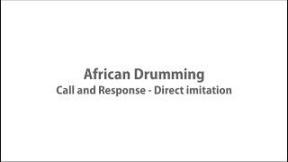
Alternatively, and a little more impressive, are the types of Call and Response where the rest of the Djembe group play a different response to that of the leader, showing that a complex set piece or interaction has been learned


Click here to watch the accompanying video.
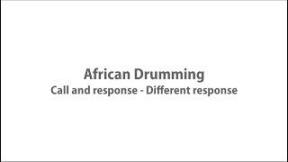
To make both styles of Call and Response easier, people quite often attach words to the rhythms. Spoken word does have its own natural rhythm and if you repeat a phrase over and over you will hear patterns form.
With call and Response some simple phrases can turn into really good syncopated rhythms that can be used effectively and be easy to remember.


Click here to watch the accompanying video
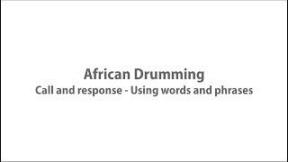
Elements taken from Andy Gleadhill’s African Drumming Book 1, Pages 19-21
When a rhythm has been established it is traditionally down to the Master Drummer to do some solo work over the top. There are many established approaches to soloing, so whichever route you take will be acceptable in a classroom environment.
A good technique to latch on to is to find the gaps in the accompanying rhythm and start your solo on one of those. The audience will be used to hearing the gap so when an instrument suddenly plays at that point and continues it draws attention to it. The soloist may not be louder than the core group, but that initial punch is enough to grab focus for people to key in to. The off-kilter or syncopated feel that this may create will also lead to an interesting polyrhythm of sorts.


Click here to watch the accompanying video.

a. Andy Gleadhill books
Andy Gleadhill has produced some wonderful resources for non-specialist class teachers and these also provide very useful support for music specialists who are teaching West African Drumming for the first time. Andy Gleadhill’s African Drumming Book 1 covers all the basics (culture, technique, elements of music, warm-ups) and gives a suggested ten session breakdown approach to teaching the content. Also included are ten different rhythms and teaching notes for each, which have been simplified for beginners or Primary setting. His second book is a more substantial tome and contains more advanced information about playing the djembe, as well as other traditional African percussion instruments that can extend the ensemble and contains some more in-depth scores that can in turn be re-adapted to suit your own classroom percussion content.
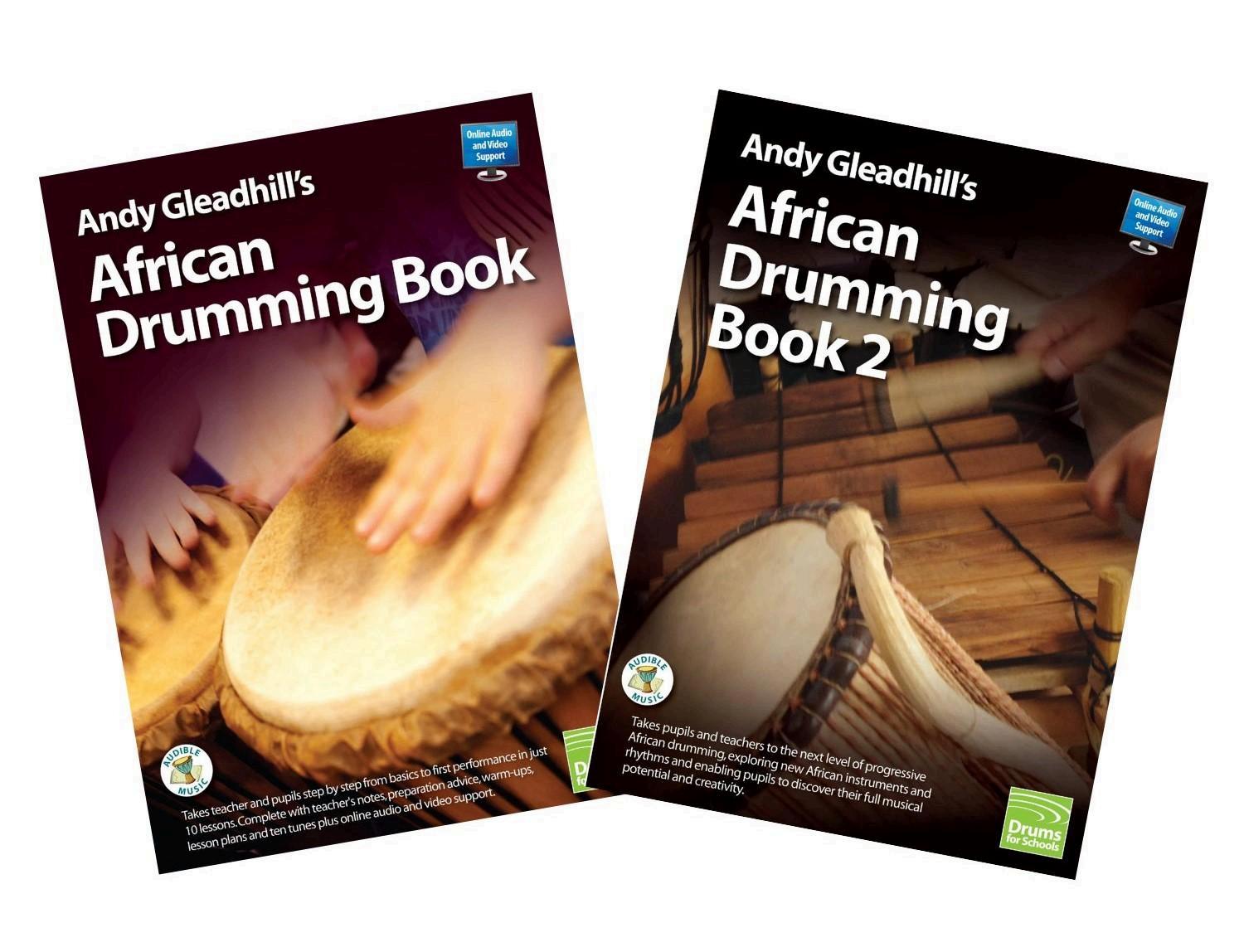

Drums for Schools has put together a completely free 10-week scheme of work which can be adapted for either KS2 or KS3 to introduce your classes to the music of West Africa via the Djembe drum.
This scheme of work explores the many and varied musical styles of West Africa through the use of traditional Djembe drums. It will introduce your class to the basics of Djembe drumming, get them playing a variety of authentic music from the different countries of West Africa, and challenge their perceptions about music from this region.
The scheme of work is mapped to the National Curriculums of each country in the UK, and reflects the recommendations of the Ofsted Music Subject Report 2023. It includes opportunities to sing, play, and listen to authentic music from various different countries across West Africa, and to improvise and compose with stylistic awareness. This progressive 10 week scheme is fully inclusive and designed to engage and motivate your students in their music lessons.
Click here to hear the audio tracks that accompany Andy Gleadhill’s West African Drumming Book 1, and you can also download them. The recordings are of professionally produced performances by school children of all the African tunes in the book. We recommend that you listen to the tunes either through headphones or good quality speakers as laptop and small loudspeakers will struggle to reproduce the lower frequencies and may sound rather “tinny”.
We’ve created a range of video clips to support your teaching. They’re subdivided into playlists as set out below. Just click on each link to access them.
West African Drumming – Video, Lesson Plan Support
Short clips that provide examples of the techniques and exercises in the Scheme of Work.

West African Drumming – Video, How to Play
Short clips demonstrating the basic technique for playing each instrument.
West African Drumming – Video, Teacher CPD & Workshops
Clips from some Andy Gleadhill workshops.
West African Drumming – Instruments
Overviews of each of Drums for Schools West African instruments.
West African Drumming – Performances
Videos of African Drumming ensembles performing. Great to give you an idea of what’s possible. Includes dundun and djembe soloing.
West African Drumming - Maintenance
A clip showing how to tighten a drum using the traditional “Mali weave” technique.